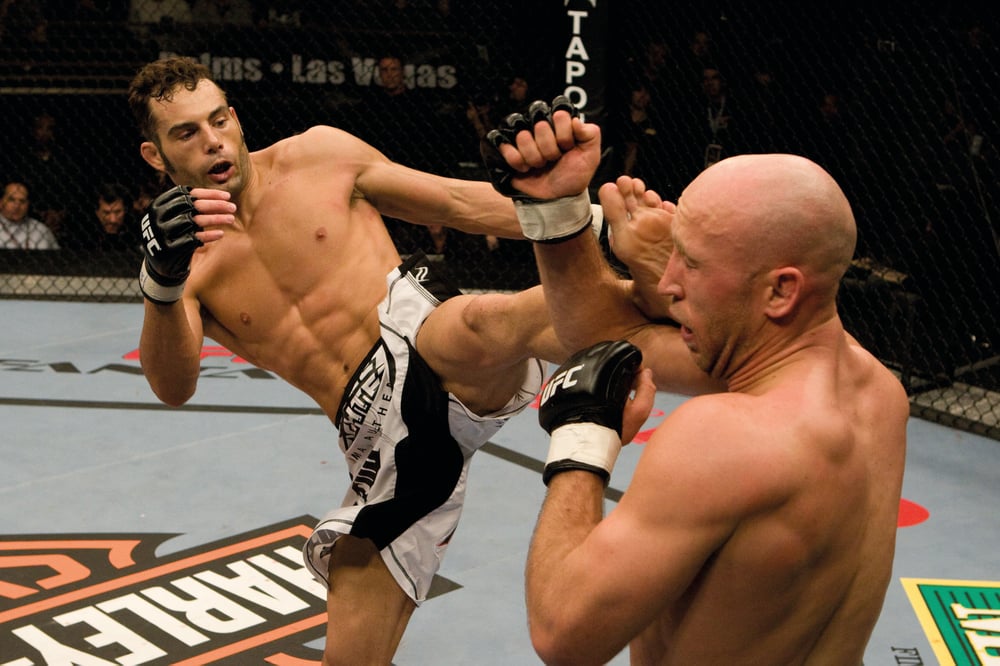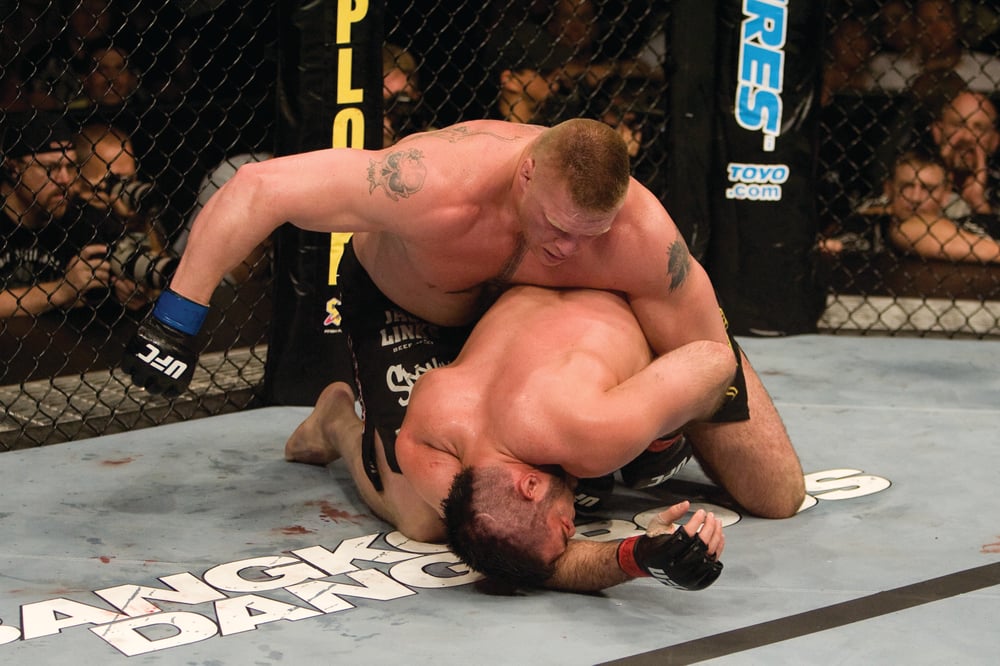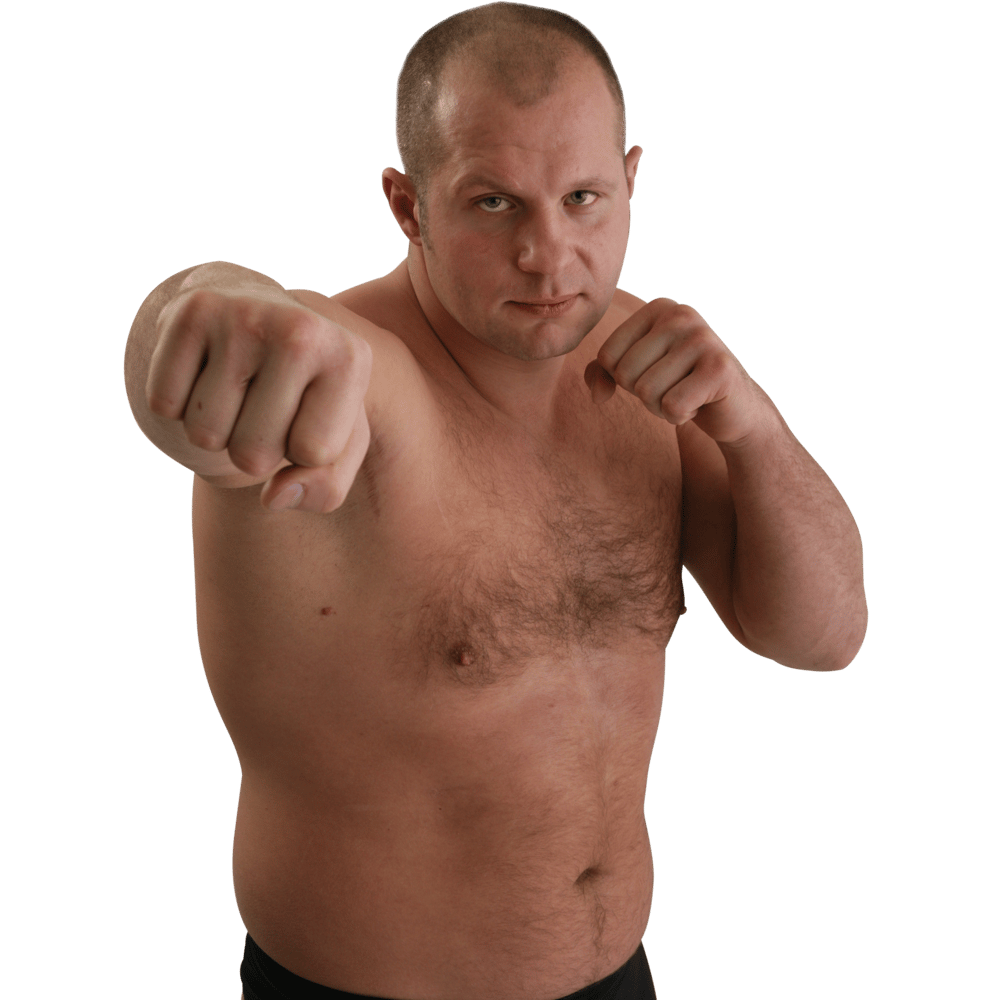
Issue 054
September 2009
A fighter’s body is everything. It is the tool of his trade, his livelihood, his greatest asset next to the intangible qualities of heart, skill and determination. As with any professional athlete, without his body, the fighter is nothing.
Outside of fighting, most athletes end up competing in their chosen sport due to their genetics. When was the last time you saw a 6’6” horse jockey, or a 125lb basketball player? You won’t see sprinter with short legs, or a tall and skinny powerlifter.
When you think of the defining characteristics of a fighter, you might instantly think of the classic tell-tale signs; the cauliflower ears, the deformed knuckles, the missing teeth. But what about the hunched posture, the over-developed anterior deltoids, the broad, flat chests and the flat feet? All of these are byproducts of being a fighter due to the very specific nature of combat.
MMA is a sport where you will encounter many different body types. From the short and stocky to the slim and slender, fighters come in all shapes and sizes, but is it their body type that dictates their style as a fighter, or their style that develops their physique? Renowned strength and conditioning coach Kevin Kearns, who has worked with fighters such as Kenny Florian, Daniel Gracie, Marcus Davies, Kurt Pellegrino and more, thinks that it’s a bit of both. “You could say the style will dictate the body type, because if you’re doing the same type of repetitive work over and over you will develop certain muscle mass and definition, but a short person will lean more to being a wrestler, while a taller, leaner person will be more a long range fighter.”

When Martin Rooney, author of Training for Warriors and principal strength and conditioning trainer to the Renzo Gracie Fight Team, first met the grapplers and mixed martial artists he would be working with, he found that while in good condition compared to the average athlete, they all suffered from unbalanced muscle groups brought on by the specific nature of their training. He found they all had excellent gripping ability and hyper-developed pulling muscles, with huge forearms and latissimus dorsi (even tibialis anterior, the muscle that runs down the outside of your shin, from playing guard), but none of them had a well-developed ‘posterior chain’. Because nearly all of them (including the MMA fighters) were gi grapplers, most of the pulling they did was from their backs when playing guard, so they had no hamstrings or glutes. He started them off with exercises including kettlebell lifts and sled dragging and had soon completely changed their physiques.
Trainers who work with fighters are met with a number of challenges. First, they must take into account the genetic make-up of the combatants, what suits their body best and what their strengths and weaknesses are. Then they must consider the fighter’s style, strategies and so on. Add to this the varied nature of MMA and how fighters must prepare for every eventuality, and it’s obvious that preparing a fighter for battle is no easy task.
For example, 80% of energy for strikers is derived from the anaerobic system, while 20% is from aerobic. If a trainer insists his fighter does miles and miles of roadwork every day, he’s completely neglecting the most important thing his fighter should be developing.
In the following pages, we take a close look at the physical make-up of common types of MMA fighters, namely strikers, grapplers, jiu-jitsu stylists and all-rounders. Kevin Kearns gives his expert view on the defining characteristics of each, while Fighters Only’s resident strength and conditioning madman Barry Gibson provides sample workouts designed to either help those who identify with that style, or those who wish to develop that type of physique.

STRIKERS
Long limbed and lithe, strikers tend to carry little body fat on either their limbs or their torsos. Lean and lanky, they are able to pick opponents off at range thanks to their greater reach. Their light frames mean they’re often quick on their feet and very mobile around the Octagon.
Without any muscle bulk to slow them down, their punches and kicks are faster but no less powerful than those of chunkier opponents – they may not have the same weight behind the punch, but excellent biomechanics and technique means they can direct plenty of explosive power at their target.
Strikers can be identified by their broad, flat pectoral muscles (as opposed to the rounded ‘all show, no go’ chest of the body builder), over-developed shoulders (from hours and hours spent hitting pads and bags) and hunched posture (a tucked chin is essential for a striker – if your chin is in the air, you’re going to sleep). Strikers usually have ‘wiry’ strength, yet can sometimes find themselves out-muscled by powerful grapplers.
The Expert’s View
“Fighters have got to keep their hands up, their back muscles are usually really well developed because they’re so used to pushing forward but they’re pulling back on the recoil, their reset time has to be fast, you have to be able to hit, reset and move quickly,” says Kevin. “Their core is really strong, they’ve got strong lower back, hips and legs.”
Notable Examples
Anderson Silva, Mike Swick, Terry Etim, Cheick Kongo.

The Striker’s Workout
Warm up with a few rounds each of skipping, footwork drills and shadow boxing to raise core temperature and get the body loosened off.
Perform 3-5 rounds of bag work, starting off with just hands, bringing in elbows knees and kicks in later rounds. Keep the intensity at around 70% of maximum effort.
Have a pad man hold Muay Thai pads or focus mitts for 3-5 rounds of striking drills, calling out combinations of varying complexity as he moves around and identifies any holes in your defense. Strive for technique and power in these rounds. Between each round drop and perform 10 press ups, 10 sit ups and 10 squats.
Perform 50 kicks each side in sets of 10 on a heavy bag. Do not worry about how long this takes you, instead strive for maximal effort with each shot without compromising technique.
Finish with abdominal exercises (plank variations, leg raises and medicine ball work) and stretching.

The Wrestlers
Wrestlers can be easily identified, and not just by their giant cauliflower ears. Those most naturally suited to wrestling tend to be stockier than average, with thick, muscular limbs, short necks, and wide torsos.
Wrestlers are almost always in fearsome physical condition. Whereas martial arts tend to emphasize technique over brute strength, wrestlers understand that to make technique work you need to back it up by being in good shape. Wrestlers develop their anaerobic fitness by training in short, sharp bursts of activity, which is great for burning fat – it is rare to see a decent wrestler carrying any extra body fat. They supplement this with strength-endurance work to keep them going through long rounds.
Their thick necks are the result of the head and neck being major control points in wrestling. To prevent injury, they strengthen their neck with bridging exercises and resistance drills with a partner. Wrestlers are big exponents of weight training for building strength, hence their often body builder-esque physiques.
The Expert’s View
“You’re not going to have guys on their toes so much in wrestling, they have to be agile but not as elusive as a boxer,” says Kevin. “Wrestlers are taught never to be on their back, so they’re going to do a lot of bridging and develop their neck and upper torso muscles. A wrestler wants to be an immovable force.”
Notable Examples
Urijah Faber, Sean Sherk, Brock Lesnar, Chael Sonnen.

The Wrestler’s Workout
Start with some pummeling drills, resistance band work, callisthenics, tumbling, cartwheels etc.
Get into the gym. Perform barbell hang cleans for 4 sets of 8.
Move into heavy dumbbell complexes, including thrusters, push presses, squats, snatches, Romanian deadlifts and so on. Perform five reps, moving from one exercise straight into the next without rest. Once all movements are completed rest only 60 seconds then repeat.
Head to the mat for rounds of live wrestling practice at approximately 75% intensity. Work on structured sequences and get your partner to add more resistance with each sequence until you are working at full capacity.

The Jiu-Jitsu Players
The classic image of the jiu-jitsu fighter is that of an under-developed martial artist, one who is reliant on skill and technique over his physical attributes. Modern jiu-jitsu fighters come in all shapes and sizes, from the muscular (think Frank Mir or Rousimar Palhares) to the skinny (Shinya Aoki or Miguel Torres).
While some jiu-jitsu fighters are in good physical shape (special under-the-counter ‘training aids’ are rife in countries such as Brazil), most prefer to spend their training time ‘rolling’ as opposed to working out. As such, they may not look in particularly good shape – it is rare to see a jiu-jitsu fighter with bulging muscles or extremely low body fat.
Jiu-jitsu fighters will often have excellent strength-endurance – if striking is a sprint, then jiu-jitsu is a marathon – their cardio means they can fight at the same pace for round after round. Their pulling muscles (such as their biceps, traps and lats) will usually be much more pronounced than their pushing muscles, developed during hours of gripping, grabbing and holding an opponent.
The Expert’s View
“Jiu-jitsu is a patient man’s sport, they call it a game of inches. You get a grip and wait for a guy to make a mistake,” says Kevin. “They’re good at pacing themselves. Their physique is deceptive because they’re often very strong, they may not look that strong but they’re so efficient at positioning and using their hips, they don’t have to build themselves up to do it.”
Notable Examples
Demian Maia, BJ Penn, Antonio Rodrigo ‘Minotauro’ Nogueira.

The Jiu-jitsu Workout
Begin with some jogging, tumbling drills, shrimping,hip mobilizing movements, etc.
Move into some bodyweight and partner calisthenics such as guard lifts, partner pulls using the gi, guard sit ups, partner press ups, gi pull-ups etc. Perform these as part of a circuit for reps or for time.
Move into ground sparring for rounds of 6-10 mins.
Finish with some isometric holds and ab circuits, e.g. guard sit-ups with a med ball, guard squeezes with a med ball or sand bag.

The All-Rounders
Over the last 15 years, MMA has evolved to the point where fighters are no longer easily pigeonholed. Gone are the days of ‘style vs style’ – instead, everyone is well-rounded with the ability to fight in every range. As such, these tend to be the fighters with the most athletic of physiques.
All-rounders will often have a healthy ‘neutral’ posture. They’re not hunched like the strikers with over-tight chests, or muscle-bound and inflexible like the wrestlers. Instead, they’re somewhere between the two, with a balanced physique that hints at their versatility. They’re often strong, quick and flexible, with a well-proportioned body, chiseled torso and muscular yet lithe limbs.
An all-rounders physique is often the most desirable of all MMA fighters. They are usually the guys who appear on the front cover of the muscle magazines, as their toned and honed V-shaped bodies match the typical athletic ideal most people aspire to. In truth, their physiques will not automatically make them a better fighter, even if it does make them a hit with the ladies.
The Expert’s View
“These guys have realized that not only do they have to wrestle, or strike, or grapple, but they have to be in shape too,” says Kevin. “You’re seeing guys with ‘between’ body types play the conditioning game, guys are saying ‘how can I up my ante?’ Guys are really pushing this element and these guy’s conditioning is off the hook.”
Notable Examples
Georges St Pierre, Nate Marquardt, Lyoto Machida.

The All-Rounders Workout
Start off with a light warm-up on an airdyne bike at a steady pace, followed by stability ball balance drills – push-ups, hyperextensions, knee tucks, etc.
Move onto complex pairs for power development e.g. one-arm dumbbell bench press, followed immediately by plyometric push-ups; weighted pull-ups followed immediately by medicine ball slams; weighted pistols immediately followed by jump squats.
MMA drills and pad work combos with sprawls, e.g. six-punch combination on pads / sprawl / hop over a floor bag / pummel for 30 seconds, then repeat for desired time.
• Scrambling drills for spatial awareness and getting back to the feet e.g. over / unders, side hops, ankle pick drills, cage escapes, spinning round for 10 sec, followed immediately by shadow boxing.

The Fedor Workout
Along with fighters such as GSP, Fedor’s workouts are among the most viewed on sites such as YouTube. But anyone expecting to find state of the art facilities and training methods will be sorely disappointed. Most of Fedor’s training takes place in a kids’ playground and an old gymnasium with tatty judo mats. This doesn’t stop him from honing his body with lots of old time strength training methods, including methods regular readers of Fighters Only will most likely be familiar with.
Warm-up:
Shadow box with light hand weights for one 5-min round. From time to time spin around 10-12 times, enough to induce dizziness, and upon stopping immediately throw big punch combinations – this simulates being rocked and fighting on.
Light jog in the Russian mountains – throw in some black bear wrestling on the way!
Main Workout:
Kettlebell snatches (left and right), 30 sec
Sledgehammer strikes / medicine ball slams, 30 sec each side
Pull-ups (kipping or strict), 30 sec
Lie on back, cycle legs touching opposite knees to elbows, 30 sec
Alternating floor press, 30 sec
Sledgehammer strikes / medicine ball slams, 30 sec each side
Pull-ups, 30 sec
V-ups, 30 sec
Sparring:
Beat up your younger siblings and poor Roman Zentsov
GNP drills using a live partner rather than a dummy
Destroy limbs using your.detailed medical files on human anatomy!

Where does Fedor fit?
There is a man some say is the ‘ultimate’ MMA fighter, a man with the mind of a soldier, the heart of a warrior, and the love handles of a pregnant woman with a craving for Macdonald’s. Though he’s not much to look at, Fedor Emelianenko’s body could be one of the reasons he is widely regarded as the best MMA fighter in the world. “What does a good athlete look like? He’s beaten some of the best athletes in the sport,” says Barry.
One glance at Fedor’s body tells you this is a body built for performance and not for show. Ever so slightly chubby, the Russian’s physique is deceptive – he has a number of startling physical attributes that make him a formidable athlete.
With a classic ‘apple-shaped’ body, Fedor’s bulk is contained not in his arms or legs, but in his barrel chest. This dense, extremely strong core is what makes Fedor such an animal in the clinch. Due to the way he is built, his strong torso makes him an excellent grappler when standing or on the floor. As with the best wrestlers, his stocky, muscular torso means he is suited to upper body pushing and pulling, while his extensive judo and sambo training has given him an extensive repertoire of upper-body throws and takedowns, all made the more effective by his bear-like strength.
His arms and legs may look out of proportion to his chunky upper body, but herein lies another crucial factor in Fedor’s success as an athlete. As he is not slowed down by layers of muscle on his arms or shoulders, his punching is fast and fluid, and though he tends to keep them in reserve he is a capable and flexible kicker (for a perfect example, see his fight against Cro Cop, where he used the Croatian kickboxers own best weapons against him).
Possibly Fedor’s greatest physical attribute is one hidden from plain sight. His acceleration is incredible – he can go from a standing start to throwing a vicious flurry of punches before most opponents have time to react, hinting at a high number of fast-twitch muscle fibers.
Just to prove that he is actually human, Fedor suffers from a condition common to many big hitters – fragile hands. He had to undergo extensive surgery on his right thumb in 2006, and there is a large silver scar across his forehead where he suffered a massive cut in his fight with Nogueira in 2004. Aside from these though, there are few chinks in his armor.

The Freaks
Notable Examples: Butterbean, Tim Sylvia, Bob Sapp.
Not every fighter can be easily described. The art of combat is an unpredictable and sometimes mystifying entity, so the athletic make up of its participants isn’t as straight forward as in other sports. In Olympic events you would expect a
sprinter to have a very difficult build to that of a shot-putter, but in MMA the shot-putter could make just as good a fighter as the sprinter.
Occasionally, someone with a ‘freakish’ physique turns up and blows away the preconceived notions of what is possible in the ring or cage. How would a 6’1” heavyweight deal with the enormous reach advantage of someone the size of a basketball player? Is it possible to take someone down from the clinch when you can’t even lock your arms around their torso?
Look at the rotund Butterbean, often a laughing stock among fans, but a man with a skull and neck so thick he has never been knocked out. Look at the lumbering, pigeon-toed Tim Sylvia, whose 6’8” frame made him one of the most difficult fighters to deal with. You can’t train to be a freak – you’re simply made that way – but those who are can turn their physiques into a useful weapon in its own right.










